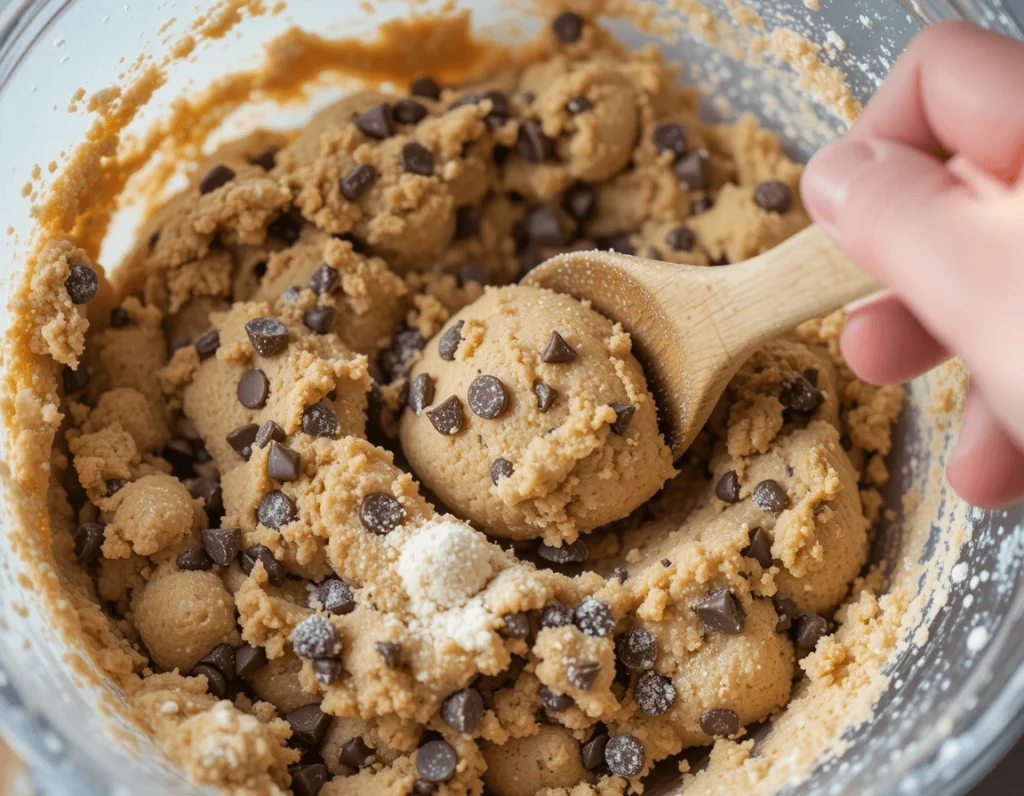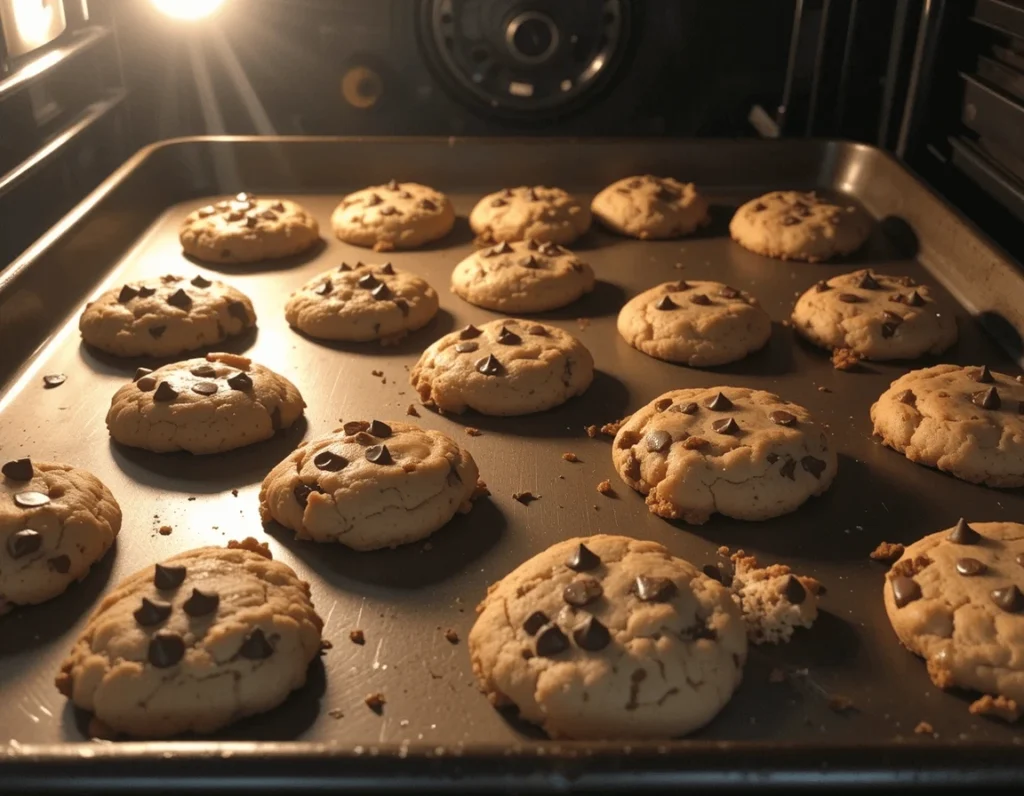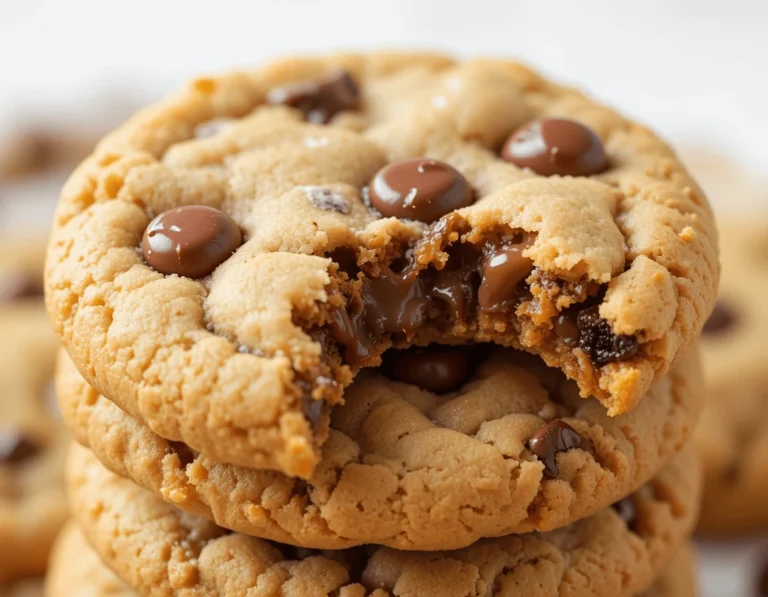Introduction
Chocolate chip cookies are a classic dessert beloved by many around the world. Whether you’re baking for a special occasion or simply craving a sweet treat, the process of making these soft, chewy, or crispy delights never fails to bring joy. However, achieving the perfect chocolate chip cookie is an art that requires some guidance, from choosing the right ingredients to baking at the ideal temperature.
In this ultimate guide, we’ll take you through every step of the cookie-baking process. From the best ingredients to the perfect baking techniques, we’ve got you covered. Plus, we’ll answer some frequently asked questions to ensure that your cookies turn out just the way you want them. By the end of this article, you’ll be equipped with all the knowledge you need to bake the perfect chocolate chip cookies every time.
Introduction to Chocolate Chip Cookies
Why Chocolate Chip Cookies Are the Favorite for All Ages
Chocolate chip cookies are universally loved for several reasons. They evoke feelings of comfort and nostalgia, making them a go-to treat for every occasion. Below is a table that highlights some of the key reasons why chocolate chip cookies remain the favorite dessert for so many.
| Reason | Explanation |
|---|---|
| Nostalgia and Tradition | For many, chocolate chip cookies represent fond memories, such as baking with family or friends. |
| Versatility | They can be made in different textures, flavors, and variations (e.g., chewy, crispy, with nuts). |
| Comforting Taste | The combination of chocolate and dough is universally satisfying, offering the right balance of sweetness and richness. |
| Easy to Customize | You can change ingredients to suit various dietary preferences (e.g., gluten-free, vegan) without losing the cookie’s essence. |
| Perfect for All Occasions | From casual snacks to special celebrations, chocolate chip cookies are suitable for all types of events. |
History and Evolution of the Classic Chocolate Chip Cookie
The evolution of chocolate chip cookies from their accidental invention to their modern-day variations is both interesting and inspiring. Here’s a timeline to visualize the major milestones in the cookie’s history:
| Year | Event |
|---|---|
| 1938 | Ruth Wakefield invented the chocolate chip cookie at the Toll House Inn in Massachusetts. |
| 1939 | Nestlé and Ruth Wakefield partnered to create Nestlé’s Toll House chocolate chips. |
| 1950s | The chocolate chip cookie became a staple in American households, with home bakers and companies alike adopting the recipe. |
| 1980s | Various cookie variations emerged, including chunky cookies and those with added ingredients like nuts, oats, and dried fruit. |
| 2000s+ | The chocolate chip cookie’s popularity spread internationally, with numerous fast-food chains and bakeries offering them. |
Table of Contents
Table of Contents
Essential Ingredients for Chocolate Chip Cookies
Choosing the Best Flour and Sugars for Perfect Texture
The choice of flour and sugar can have a huge impact on the texture and flavor of your cookies. Here’s a breakdown of the key flour and sugar types used in chocolate chip cookies and their effects:
| Ingredient | Function in Cookies | Best for | Common Alternatives |
|---|---|---|---|
| All-Purpose Flour | Provides structure to the dough and helps it hold together. | Classic chocolate chip cookies | Gluten-free flour blend |
| Cake Flour | Lighter and produces a more tender, delicate texture. | Soft, delicate cookies | Use less cake flour and mix with all-purpose flour |
| Granulated Sugar | Helps the cookies spread and become crispier. | Crispy cookies | Coconut sugar, Stevia (for a lower glycemic index) |
| Brown Sugar | Adds moisture and a rich, caramel-like flavor. | Chewy cookies | Coconut sugar, Maple syrup (for more moisture) |
Selecting the Right Type of Chocolate Chips
Choosing the right chocolate can dramatically change the flavor and texture of your cookies. Here’s a table to help you choose the best chocolate for your chocolate chip cookies:
| Chocolate Type | Flavor Profile | Best for |
|---|---|---|
| Semi-Sweet Chocolate Chips | Balanced sweetness and bitterness, the classic choice for cookies. | Standard chocolate chip cookies |
| Milk Chocolate Chips | Creamier, sweeter taste with a smooth texture. | Those who prefer a sweeter cookie and a more indulgent treat. |
| Dark Chocolate Chips | Rich, intense chocolate flavor with lower sweetness. | For a more sophisticated, bittersweet cookie. |
| White Chocolate Chips | Sweet, milky, and creamy taste, often used for variations. | Unique, creamy cookies that pair well with fruits and nuts. |
| Mini Chocolate Chips | Smaller size creates an even chocolate distribution. | Uniform chocolate throughout cookies or more subtle chocolate flavor. |

Step-by-Step Guide to Baking Perfect Chocolate Chip Cookies
Mixing Your Ingredients to Achieve the Right Dough Consistency
Now that you have all the necessary ingredients, it’s time to start mixing the dough. The order in which you combine the ingredients can make a big difference in the texture of your cookies.
Start by creaming the butter and sugars together. This step is important for incorporating air into the dough, which will help make your cookies soft and chewy. Be sure to use room-temperature butter, as this will help it mix more easily with the sugars. Once the butter and sugars are fully combined, add in the eggs and vanilla extract. These wet ingredients help bind the dough together and contribute to the cookies’ texture and flavor.
Next, gradually add the dry ingredients—flour, baking soda, and any other dry seasonings (such as salt or cinnamon). It’s best to sift the flour and baking soda together to ensure there are no lumps and to evenly distribute the baking soda throughout the dough. When mixing in the dry ingredients, do so slowly to avoid overmixing, which can lead to tough cookies.
Finally, fold in the chocolate chips (or chopped chocolate) by hand. This ensures that the chocolate chips are evenly distributed throughout the dough without breaking them into smaller pieces.
How to Preheat and Prepare Your Oven for Baking
Preheating your oven to the correct temperature is crucial to ensuring your cookies bake evenly. Chocolate chip cookies are typically baked at 350°F (175°C), but be sure to adjust the temperature if you’re using a convection oven or baking at high altitudes. It’s a good idea to use an oven thermometer to double-check that your oven is reaching the right temperature, as ovens can sometimes run hot or cold.
Before placing the cookie dough on the baking sheets, line them with parchment paper or silicone baking mats. This helps prevent the cookies from sticking to the pan and allows for even baking. Also, make sure to leave enough space between the cookie dough scoops, as the cookies will spread out while baking.
Once the dough is ready and the oven is preheated, it’s time to bake! However, remember to keep an eye on the cookies to avoid overbaking. The perfect chocolate chip cookie should be golden brown on the edges, but still soft in the center.

Tips and Tricks for Soft and Chewy Chocolate Chip Cookies
How to Keep Your Chocolate Chip Cookies Soft and Moist
One of the most sought-after qualities of a chocolate chip cookie is its softness. While some people love crispy cookies, many prefer soft, chewy ones that melt in your mouth. Here are some key tips to achieve that texture:
- Use more brown sugar: As mentioned earlier, brown sugar adds moisture to the cookie dough. By increasing the ratio of brown sugar to granulated sugar, you’ll end up with a softer, chewier cookie.
- Chill the dough: Chilling the dough before baking allows the flour to fully absorb the liquid in the dough. This results in a thicker dough that spreads less during baking, giving you a thicker, chewier cookie.
- Underbake slightly: A common mistake is overbaking the cookies. To ensure a soft texture, remove the cookies from the oven when they’re just beginning to turn golden around the edges. The cookies will continue to bake on the baking sheet as they cool, and this will keep them soft.
- Add a bit of cornstarch: Adding a small amount of cornstarch (about 1-2 teaspoons) to the flour helps the cookies stay soft by preventing them from spreading too much during baking.
Secrets to Getting the Perfect Cookie Crispness
While chewy cookies are a favorite for many, some people prefer a crispier version. To achieve that perfect crispness:
- Increase granulated sugar: Granulated sugar helps cookies spread more and gives them a crispier texture. Increasing the ratio of granulated sugar compared to brown sugar will result in crispier cookies.
- Use a thinner dough: Avoid chilling the dough for too long, as this can make the dough too thick. You want the dough to be slightly thinner to allow for more spread.
- Bake a little longer: For a crispy cookie, you can bake your cookies a little longer than usual, until they’re golden brown all over, not just on the edges.

Common Mistakes to Avoid When Baking Chocolate Chip Cookies
Overmixing Dough: The Resulting Toughness
Overmixing cookie dough is one of the most frequent mistakes people make, and it can drastically affect the texture of the cookies. When you overmix the dough, you activate the gluten in the flour, which can lead to a tougher, chewier cookie that isn’t as soft and tender as you might expect.
Gluten is a protein found in wheat flour that gives structure to baked goods, but in cookies, you want just enough gluten to provide a little structure without making the cookies dense or tough.
How to Avoid Overmixing:
- Mix gently: When combining the flour with the wet ingredients, mix only until the dry ingredients are incorporated. It’s okay if the dough is slightly lumpy—this will help prevent the activation of too much gluten.
- Use the right speed: If you’re using an electric mixer, start on a low speed. High speeds can cause the dough to mix too vigorously, leading to overmixing.
- Add-ins last: Once the flour is incorporated, fold in the chocolate chips and any other mix-ins by hand. This ensures the dough is evenly mixed without excessive handling.
Using the Wrong Baking Temperature
The baking temperature of your oven plays a crucial role in the success of your chocolate chip cookies. If the temperature is too high, the cookies will spread too quickly and become thin and overly crispy. If the temperature is too low, the cookies may not spread enough and can turn out thick and doughy, with an undercooked interior.
Using the wrong temperature can also cause uneven baking, leading to some cookies being overdone while others are underdone. It’s essential to ensure that your oven is at the correct temperature and that the heat is distributed evenly.
How to Avoid Baking at the Wrong Temperature:
- Preheat your oven: Always preheat your oven to the required temperature before placing the cookies inside. This ensures that your cookies bake evenly and that they don’t start spreading too soon in a cold oven.
- Use an oven thermometer: Oven temperatures can vary, so it’s a good idea to use an oven thermometer to verify the temperature. This ensures your oven is accurate, preventing any temperature fluctuations during baking.
- Check for hot spots: If you find that your cookies are baking unevenly, your oven may have hot spots. In such cases, try rotating the baking sheet halfway through the baking time for more even results.
- Consider your baking sheet: A dark baking sheet absorbs more heat and can cause cookies to brown too quickly. Lighter-colored or shiny baking sheets reflect heat, helping cookies bake more evenly. If using dark sheets, you may need to reduce the baking time slightly.
Not Chilling the Dough
Chilling the dough is another common mistake that affects the texture and spread of your cookies. If you don’t chill your cookie dough, the cookies will spread too much during baking, resulting in thin, crispy cookies. Chilling the dough helps solidify the fats in the dough (like butter), which slows down the spreading process as the cookies bake, allowing them to hold their shape.
How to Avoid This Mistake:
- Chill the dough for at least 30 minutes: If you’re in a rush, even a brief chilling period can make a difference. For best results, chill the dough for at least 30-60 minutes.
- Longer chilling for thicker cookies: If you prefer thicker, chewier cookies, chill the dough for longer—up to 24 hours if you can plan ahead. This also allows the flour to fully absorb the liquid, resulting in a better texture.
- Freeze for later: If you want to bake cookies fresh every time, you can freeze the dough. Scoop the dough onto a baking sheet and freeze it for 30 minutes before transferring the dough balls to a freezer bag for long-term storage. You can then bake the dough straight from the freezer.
Not Using Enough Baking Soda or Baking Powder
Baking soda and baking powder are responsible for helping your cookies rise and spread. Not using enough of these leavening agents can lead to dense, flat cookies, while too much can cause the cookies to spread too much or have an off taste. It’s essential to measure accurately.
How to Avoid This Mistake:
- Use a proper measuring spoon: Don’t use a regular spoon from your kitchen drawer to measure baking soda or powder, as it can lead to inaccurate measurements. Always use a proper measuring spoon.
- Check your baking soda: If your baking soda is old or expired, it might not be as effective. Ensure your baking soda is fresh by testing it. Simply place a small amount of baking soda in vinegar—if it bubbles, it’s still active.
Using Cold Butter or Margarine
Many bakers mistakenly use cold butter directly from the fridge, thinking that it will result in firmer cookies. However, cold butter makes it harder to cream the butter with sugar, and it leads to uneven mixing. As a result, the cookies may not spread evenly or have the right texture.
How to Avoid This Mistake:
- Use softened butter: Allow your butter to soften at room temperature before mixing. It should be soft enough to leave an indentation when pressed with a finger but not melted. This allows the butter to mix more evenly with the sugars, resulting in a smoother dough and a better texture in the cookies.
Using Too Much Flour
Adding too much flour to your dough will result in a dry, crumbly cookie. This can happen if you scoop the flour directly from the bag and pack it into the measuring cup. If the flour is packed, you’re likely using more than the recipe calls for, which will affect the texture.
How to Avoid This Mistake:
Use a kitchen scale: If possible, weigh your flour with a kitchen scale for the most accurate measurement.
Spoon and level the flour: Instead of scooping the flour with your measuring cup, spoon the flour into the cup and level it off with a knife. This method prevents you from packing in extra flour.
Creative Variations of the Classic Chocolate Chip Cookie
Add-ins and Mix-ins: Nuts, Dried Fruit, and More
While the classic chocolate chip cookie is delicious on its own, you can easily customize your cookies by adding extra ingredients. Here are some ideas for fun and creative variations:
- Nuts: Walnuts, pecans, or almonds add a wonderful crunch and nutty flavor to your chocolate chip cookies. Add 1/2 cup to 1 cup of chopped nuts to the dough for extra texture.
- Dried fruit: Dried cranberries, cherries, or raisins pair wonderfully with chocolate chips for a sweet and tart contrast. Add up to 1 cup of dried fruit to the dough for a fruity twist.
- Shredded coconut: Coconut adds an extra layer of flavor and texture to chocolate chip cookies. Add 1/2 cup of shredded coconut to the dough for a tropical touch.
How to Make Gluten-Free or Vegan Chocolate Chip Cookies
Whether you have dietary restrictions or are simply trying to try something different, it’s easy to make gluten-free or vegan chocolate chip cookies.
Gluten-Free Version: Substitute the all-purpose flour with a gluten-free flour blend. Make sure the blend includes xanthan gum, as this helps provide the structure needed for gluten-free cookies. You can also use almond flour for a slightly different texture and flavor.
Vegan Version: To make vegan chocolate chip cookies, substitute the butter with a non-dairy butter or coconut oil. Instead of eggs, use flax eggs (1 tablespoon of ground flaxseed mixed with 3 tablespoons of water per egg). Make sure your chocolate chips are dairy-free as well.
How to Store Chocolate Chip Cookies for Freshness
The Best Ways to Store Cookies to Keep Them Fresh
Proper storage is essential to keep your chocolate chip cookies fresh. Here are a few tips for storing them:
- Room Temperature: Store your cookies in an airtight container at room temperature for up to 1 week. If the cookies are soft, placing a piece of bread inside the container will help maintain moisture and softness.
- Freezing: If you want to keep cookies for a longer period, freezing is a great option. Place the cookies in an airtight container or freezer bag and freeze for up to 3 months. When you’re ready to eat them, simply thaw at room temperature for a few hours or warm them up in the microwave for a few seconds.
Freezing Chocolate Chip Cookies for Later
For those who love fresh-baked cookies but don’t have time to bake every day, freezing cookie dough is a convenient option. After scooping out the dough onto a baking sheet, freeze the dough balls for about 30 minutes. Once frozen, transfer the dough balls to an airtight container or freezer bag and store them in the freezer. When you’re ready to bake, just place the frozen dough balls on a baking sheet and bake at the normal temperature for an extra 1-2 minutes.
Frequently Asked Questions (FAQ)
How Do I Make My Cookies Chewy Instead of Crispy?
To make your cookies chewy, use more brown sugar than granulated sugar, and avoid overbaking them. Also, make sure to chill the dough before baking.
Can I Use White Chocolate Chips Instead of Regular Chocolate?
Yes, white chocolate chips are a delicious alternative to regular chocolate. They add a creamy, sweet flavor to the cookies. Feel free to experiment with different types of chocolate chips to find your perfect combination.
Why Are My Chocolate Chip Cookies Spreading Too Much?
If your cookies are spreading too much during baking, the dough may be too warm. Make sure to chill the dough for at least 30 minutes before baking, and check that you’re using the correct amount of flour.
How Can I Make My Cookies Less Sweet?
To reduce the sweetness of your cookies, try using less sugar or replacing some of the sugar with a lower-sugar substitute. You can also use dark chocolate chips, which have a less sweet taste than milk chocolate.
Can I Substitute Butter with Margarine?
Yes, margarine can be substituted for butter in chocolate chip cookies, but it may affect the flavor and texture slightly. Use margarine that’s designed for baking for the best results.
How Long Do Homemade Chocolate Chip Cookies Last?
When stored in an airtight container at room temperature, homemade chocolate chip cookies will stay fresh for about a week. For longer storage, freeze them as described above.
Conclusion and Final Thoughts on Chocolate Chip Cookies
Why Homemade Chocolate Chip Cookies Are Worth the Effort
Baking homemade chocolate chip cookies is not just about the delicious end product but also about the experience. The process of mixing the dough, watching the cookies bake, and sharing them with friends and family is a rewarding experience that makes the cookies taste even better.
Best Serving Suggestions for Your Perfect Cookies
Chocolate chip cookies are best served fresh out of the oven with a glass of milk, but they can also be enjoyed with coffee, tea, or a scoop of vanilla ice cream. For a fun twist, sandwich two cookies together with a scoop of ice cream to create a delicious cookie ice cream sandwich!
For more amazing recipes that you’ll surely love : here’s the link
Print
The Ultimate Guide to Baking Perfect Chocolate Chip Cookies
These chocolate chip cookies are the perfect combination of soft, chewy, and slightly crispy edges. Loaded with gooey chocolate chips and a hint of vanilla, they’re the ultimate comfort food.
- Total Time: 25-30 minutes
- Yield: 24 cookies 1x
Ingredients
2 1/4 cups all-purpose flour
1/2 teaspoon baking soda
1 cup unsalted butter, room temperature
1/2 cup granulated sugar
1 cup packed brown sugar
2 teaspoons vanilla extract
2 large eggs
2 cups semisweet chocolate chips
1/2 teaspoon salt (optional)
1/2 cup chopped walnuts or pecans (optional, for extra texture)
Instructions
Preheat the oven to 350°F (175°C) and line two baking sheets with parchment paper.
In a medium-sized bowl, whisk together the flour, baking soda, and salt (if using). Set aside.
In a large bowl, cream the butter and both sugars together until light and fluffy, about 3-4 minutes.
Add the eggs one at a time, mixing well after each addition. Stir in the vanilla extract.
Gradually add the dry ingredients to the wet ingredients, mixing just until combined.
Fold in the chocolate chips (and nuts, if using) with a spatula.
Scoop the dough into tablespoon-sized balls and place them on the prepared baking sheets, spacing them about 2 inches apart.
Bake for 10-12 minutes, or until the edges are golden brown but the centers are still soft. Keep an eye on them as ovens vary.
Remove from the oven and allow the cookies to cool on the baking sheets for 5 minutes before transferring them to a wire rack to cool completely.
Notes
For chewy cookies, underbake them slightly. They will continue to bake on the sheet as they cool.
You can chill the dough for 30 minutes before baking to prevent the cookies from spreading too much.
If you like crunchy cookies, bake them a little longer until the edges are deep golden.
- Prep Time: 15 minutes
- Cook Time: 10-12 minutes
- Category: Dessert, Baking, Cookies
- Method: Baking
- Cuisine: American
- Diet: Vegetarian
Nutrition
- Serving Size: 1 cookie
- Calories: 200
- Sugar: 22g
- Sodium: 95mg
- Fat: 10g
- Saturated Fat: 6g
- Unsaturated Fat: 3g
- Trans Fat: 0g
- Carbohydrates: 30g
- Fiber: 1g
- Protein: 2g
- Cholesterol: 25mg
Keywords: Chocolate chip cookies, chewy cookies, homemade cookies, baking, easy cookie recipe, best chocolate chip cookies


